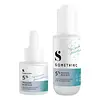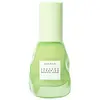What's inside
What's inside
 Key Ingredients
Key Ingredients

 Benefits
Benefits

 Concerns
Concerns

No concerns
 Ingredients Side-by-side
Ingredients Side-by-side

Rosa Damascena Flower Water 48%
MaskingGlycerin
HumectantNiacinamide 5%
SmoothingWater
Skin ConditioningMethylpropanediol
SolventSodium PCA
HumectantBetaine
Humectant1,2-Hexanediol
Skin ConditioningZinc PCA
HumectantAmmonium Acryloyldimethyltaurate/Vp Copolymer
Butylene Glycol
HumectantSodium Lauroyl Lactylate
EmulsifyingPentylene Glycol
Skin ConditioningXanthan Gum
EmulsifyingAdenosine
Skin ConditioningOctanediol
Ethylhexylglycerin
Skin ConditioningCeramide NP
Skin ConditioningHydrolyzed Algae Extract
Skin ConditioningAnthemis Nobilis Flower Extract
MaskingCeramide AP
Skin ConditioningPhytosphingosine
Skin ConditioningCholesterol
EmollientCarbomer
Emulsion StabilisingBeta Vulgaris Root Extract
Skin ConditioningAllantoin
Skin ConditioningCaffeine
Skin ConditioningCeramide EOP
Skin ConditioningTocopherol
AntioxidantRosa Damascena Flower Water 48%, Glycerin, Niacinamide 5%, Water, Methylpropanediol, Sodium PCA, Betaine, 1,2-Hexanediol, Zinc PCA, Ammonium Acryloyldimethyltaurate/Vp Copolymer, Butylene Glycol, Sodium Lauroyl Lactylate, Pentylene Glycol, Xanthan Gum, Adenosine, Octanediol, Ethylhexylglycerin, Ceramide NP, Hydrolyzed Algae Extract, Anthemis Nobilis Flower Extract, Ceramide AP, Phytosphingosine, Cholesterol, Carbomer, Beta Vulgaris Root Extract, Allantoin, Caffeine, Ceramide EOP, Tocopherol
Water
Skin ConditioningGlycerin
HumectantJojoba Esters
EmollientPersea Gratissima Oil
Skin ConditioningPersea Gratissima Fruit Extract
EmollientNiacinamide
SmoothingCeramide NP
Skin ConditioningCeramide Ns
Skin ConditioningCeramide AP
Skin ConditioningCeramide EOP
Skin ConditioningCeramide Eos
Skin ConditioningHydrolyzed Rice Protein
Skin ConditioningAllantoin
Skin ConditioningOryza Sativa Bran Oil
EmollientBisabolol
MaskingZingiber Officinale Root Extract
MaskingCurcuma Longa Root Extract
MaskingTocopherol
AntioxidantPalmitoyl Tripeptide-8
Skin ConditioningVitis Vinifera Fruit Extract
Skin ConditioningPotassium Palmitoyl Hydrolyzed Wheat Protein
CleansingBoswellia Serrata Extract
Skin ConditioningPopulus Tremuloides Bark Extract
AntiseborrhoeicCaprylic/Capric Triglyceride
MaskingSodium Phytate
Cetyl Alcohol
EmollientMelia Azadirachta Flower Extract
Skin ConditioningMelia Azadirachta Leaf Extract
Skin ConditioningOcimum Sanctum Leaf Extract
Skin ConditioningBehenic Acid
CleansingCholesterol
EmollientEthylhexylglycerin
Skin ConditioningOcimum Basilicum Flower/Leaf Extract
TonicElettaria Cardamomum Seed Extract
PerfumingJasminum Officinale Flower/Leaf Extract
MaskingCorallina Officinalis Extract
Skin ConditioningSodium Carbonate
BufferingSodium Chloride
MaskingCI 75810
Cosmetic ColorantCamellia Sinensis Leaf Extract
AntimicrobialCananga Odorata Flower Extract
PerfumingCaprooyl Phytosphingosine
Skin ConditioningCaprooyl Sphingosine
Skin ConditioningCucumis Melo Fruit Extract
Skin ConditioningCucumis Sativus Fruit Extract
EmollientPyrus Malus Fruit Extract
Skin ConditioningRose Extract
Skin ConditioningRubus Idaeus Leaf Extract
Skin ConditioningAscorbyl Palmitate
AntioxidantDextran
Hydroxyacetophenone
AntioxidantXanthan Gum
EmulsifyingButylene Glycol
HumectantCarbomer
Emulsion StabilisingCetearyl Olivate
Sorbitan Olivate
Emulsifying1,2-Hexanediol
Skin ConditioningCaprylyl Glycol
EmollientHydrogenated Vegetable Oil
EmollientLavandula Angustifolia Flower/Leaf/Stem Extract
MaskingSantalum Album Wood Extract
PerfumingTocopheryl Acetate
AntioxidantCeteareth-25
CleansingSodium Hydroxide
BufferingPhenoxyethanol
PreservativeSodium Benzoate
MaskingWater, Glycerin, Jojoba Esters, Persea Gratissima Oil, Persea Gratissima Fruit Extract, Niacinamide, Ceramide NP, Ceramide Ns, Ceramide AP, Ceramide EOP, Ceramide Eos, Hydrolyzed Rice Protein, Allantoin, Oryza Sativa Bran Oil, Bisabolol, Zingiber Officinale Root Extract, Curcuma Longa Root Extract, Tocopherol, Palmitoyl Tripeptide-8, Vitis Vinifera Fruit Extract, Potassium Palmitoyl Hydrolyzed Wheat Protein, Boswellia Serrata Extract, Populus Tremuloides Bark Extract, Caprylic/Capric Triglyceride, Sodium Phytate, Cetyl Alcohol, Melia Azadirachta Flower Extract, Melia Azadirachta Leaf Extract, Ocimum Sanctum Leaf Extract, Behenic Acid, Cholesterol, Ethylhexylglycerin, Ocimum Basilicum Flower/Leaf Extract, Elettaria Cardamomum Seed Extract, Jasminum Officinale Flower/Leaf Extract, Corallina Officinalis Extract, Sodium Carbonate, Sodium Chloride, CI 75810, Camellia Sinensis Leaf Extract, Cananga Odorata Flower Extract, Caprooyl Phytosphingosine, Caprooyl Sphingosine, Cucumis Melo Fruit Extract, Cucumis Sativus Fruit Extract, Pyrus Malus Fruit Extract, Rose Extract, Rubus Idaeus Leaf Extract, Ascorbyl Palmitate, Dextran, Hydroxyacetophenone, Xanthan Gum, Butylene Glycol, Carbomer, Cetearyl Olivate, Sorbitan Olivate, 1,2-Hexanediol, Caprylyl Glycol, Hydrogenated Vegetable Oil, Lavandula Angustifolia Flower/Leaf/Stem Extract, Santalum Album Wood Extract, Tocopheryl Acetate, Ceteareth-25, Sodium Hydroxide, Phenoxyethanol, Sodium Benzoate
 Reviews
Reviews

Ingredients Explained
These ingredients are found in both products.
Ingredients higher up in an ingredient list are typically present in a larger amount.
1,2-Hexanediol is a synthetic liquid and another multi-functional powerhouse.
It is a:
- Humectant, drawing moisture into the skin
- Emollient, helping to soften skin
- Solvent, dispersing and stabilizing formulas
- Preservative booster, enhancing the antimicrobial activity of other preservatives
Allantoin is a soothing ingredient known for its protective and moisturizingg properties. Because of this, it is often added to products with strong active ingredients.
Studies show higher concentrations of this ingredient can promote wound healing.
Though it can be derived from the comfrey plant, allantoin is produced synthetically for cosmetic products to ensure purity.
Learn more about AllantoinButylene Glycol (or BG) is used within cosmetic products for a few different reasons:
Overall, Butylene Glycol is a safe and well-rounded ingredient that works well with other ingredients.
Though this ingredient works well with most skin types, some people with sensitive skin may experience a reaction such as allergic rashes, closed comedones, or itchiness.
Learn more about Butylene GlycolCarbomer is a polymer of acrylic acid. Its main role is to create a gel consistency.
A high amount of carbomer can cause pilling or balling up of products. Don't worry, most products contain 1% or less of carbomer.
Ceramide AP is formally known as Ceramide 6.
Ceramides are intercellular lipids naturally found in our skin that bonds dead skin cells together to create a barrier. Having a strong skin barrier leads to more firm and hydrated skin.
They are known for their ability to hold water and thus are a great ingredient for dry skin. By bolstering the skin ceramides act as a barrier against irritating ingredients. This can help with inflammation as well.
If you would like to eat ceramides, sweet potatoes contain a small amount.
Read more about other common types of ceramides here:
Ceramide NP
Ceramide EOP
Ceramide EOP is formally known as Ceramide 1 and Ceramide 1 A.
EOP stands for a linked Ester fatty acid, a linked Omega hydroxy fatty acid, and the Phytosphingosine base.
Ceramides are intercellular lipids naturally found in our skin. They bind dead skin cells together to create a barrier. The ceramides in our skin have the ability to hold water to keep our skin hydrated.
Ceramides are an important building block for our skin barrier. A strong skin barrier helps with:
If you would like to eat ceramides, sweet potatoes contain a small amount.
Read more about other common types of ceramides here:
Learn more about Ceramide EOPCeramide NP is a type of ceramide and formally known as ceramide 3.
Ceramides are intercellular lipids naturally found in our skin that bonds dead skin cells together to create a barrier. They are known for their ability to hold water and thus are a great ingredient for dry skin.
Ceramides are an important building block for our skin barrier. A stronger barrier helps the skin look more firm and hydrated. By bolstering the skin ceramides act as a barrier against irritating ingredients. This can help with inflammation as well.
If you would like to eat ceramides, sweet potatoes contain a small amount.
Read more about other common types of ceramides here:
Ceramide AP
Ceramide EOP
Cholesterol is a class of organic molecules called lipids. It helps hydrate your skin and is essential to having a healthy skin barrier.
Our skin naturally contains cholesterol in the outermost layer. Besides cholesterol, it also contains ceramides and fatty acids. Cholesterol makes up about 1/4 of your skin's outer layer and barrier. Your skin barrier is responsible for keeping allergens and microbes out. Having a healthy skin barrier is also responsible for keeping your skin firm and plump.
Our bodies use cholestrol to create vitamin D, steroid hormones, and more.
Learn more about CholesterolEthylhexylglycerin (we can't pronounce this either) is commonly used as a preservative and skin softener. It is derived from glyceryl.
You might see Ethylhexylglycerin often paired with other preservatives such as phenoxyethanol. Ethylhexylglycerin has been found to increase the effectiveness of these other preservatives.
Glycerin is already naturally found in your skin. It helps moisturize and protect your skin.
A study from 2016 found glycerin to be more effective as a humectant than AHAs and hyaluronic acid.
As a humectant, it helps the skin stay hydrated by pulling moisture to your skin. The low molecular weight of glycerin allows it to pull moisture into the deeper layers of your skin.
Hydrated skin improves your skin barrier; Your skin barrier helps protect against irritants and bacteria.
Glycerin has also been found to have antimicrobial and antiviral properties. Due to these properties, glycerin is often used in wound and burn treatments.
In cosmetics, glycerin is usually derived from plants such as soybean or palm. However, it can also be sourced from animals, such as tallow or animal fat.
This ingredient is organic, colorless, odorless, and non-toxic.
Glycerin is the name for this ingredient in American English. British English uses Glycerol/Glycerine.
Learn more about GlycerinNiacinamide is a multitasking form of vitamin B3 that strengthens the skin barrier, reduces pores and dark spots, regulates oil, and improves signs of aging.
And the best part? It's gentle and well-tolerated by most skin types, including sensitive and reactive skin.
You might have heard of "niacin flush", or the reddening of skin that causes itchiness. Niacinamide has not been found to cause this.
In very rare cases, some individuals may not be able to tolerate niacinamide at all or experience an allergic reaction to it.
If you are experiencing flaking, irritation, and dryness with this ingredient, be sure to double check all your products as this ingredient can be found in all categories of skincare.
When incorporating niacinamide into your routine, look out for concentration amounts. Typically, 5% niacinamide provides benefits such as fading dark spots. However, if you have sensitive skin, it is better to begin with a smaller concentration.
When you apply niacinamide to your skin, your body converts it into nicotinamide adenine dinucleotide (NAD). NAD is an essential coenzyme that is already found in your cells as "fuel" and powers countless biological processes.
In your skin, NAD helps repair cell damage, produce new healthy cells, support collagen production, strengthen the skin barrier, and fight environmental stressors (like UV and pollution).
Our natural NAD levels start to decline with age, leading to slower skin repair, visible aging, and a weaker skin barrier. By providing your skin niacinamide, you're recharging your skin's NAD levels. This leads to stronger, healthier, and younger looking skin.
Another name for vitamin B3 is nicotinamide. This vitamin is water-soluble and our bodies don't store it. We obtain Vitamin B3 from either food or skincare. Meat, fish, wheat, yeast, and leafy greens contain vitamin B3.
The type of niacinamide used in skincare is synthetically created.
Learn more about NiacinamideTocopherol (also known as Vitamin E) is a common antioxidant used to help protect the skin from free-radicals and strengthen the skin barrier. It's also fat soluble - this means our skin is great at absorbing it.
Vitamin E also helps keep your natural skin lipids healthy. Your lipid skin barrier naturally consists of lipids, ceramides, and fatty acids. Vitamin E offers extra protection for your skin’s lipid barrier, keeping your skin healthy and nourished.
Another benefit is a bit of UV protection. Vitamin E helps reduce the damage caused by UVB rays. (It should not replace your sunscreen). Combining it with Vitamin C can decrease sunburned cells and hyperpigmentation after UV exposure.
You might have noticed Vitamin E + C often paired together. This is because it is great at stabilizing Vitamin C. Using the two together helps increase the effectiveness of both ingredients.
There are often claims that Vitamin E can reduce/prevent scarring, but these claims haven't been confirmed by scientific research.
Learn more about TocopherolWater. It's the most common cosmetic ingredient of all. You'll usually see it at the top of ingredient lists, meaning that it makes up the largest part of the product.
So why is it so popular? Water most often acts as a solvent - this means that it helps dissolve other ingredients into the formulation.
You'll also recognize water as that liquid we all need to stay alive. If you see this, drink a glass of water. Stay hydrated!
Learn more about WaterXanthan gum is used as a stabilizer and thickener within cosmetic products. It helps give products a sticky, thick feeling - preventing them from being too runny.
On the technical side of things, xanthan gum is a polysaccharide - a combination consisting of multiple sugar molecules bonded together.
Xanthan gum is a pretty common and great ingredient. It is a natural, non-toxic, non-irritating ingredient that is also commonly used in food products.
Learn more about Xanthan Gum